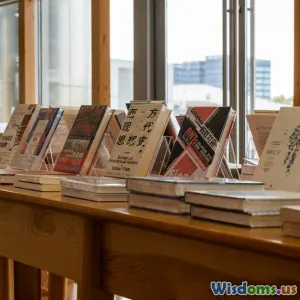
Haruki Murakami vs Banana Yoshimoto Comparing Japanese Literary Voices
8 min read Explore the distinct literary styles of Haruki Murakami and Banana Yoshimoto, two modern Japanese icons shaping global literature. (0 Reviews)
Haruki Murakami vs Banana Yoshimoto: Comparing Japanese Literary Voices
Japanese literature boasts an array of captivating voices, but few authors have captured both domestic and international imaginations like Haruki Murakami and Banana Yoshimoto. Though contemporaries in the postmodern literary landscape, their works pulse with differing rhythms, influenced by unique thematic explorations and stylistic choices. This article dives deep into their contrasting literary voices, revealing how each artist reflects and shapes the complex cultural tapestry of modern Japan.
Introduction
Since the late 20th century, Japanese literature has experienced a renaissance that captivated readers worldwide. Haruki Murakami, often credited with popularizing a surreal blend of Western and Japanese sensibilities, and Banana Yoshimoto, celebrated for her poignant exploration of youth and grief, emerge as defining figures in contemporary literature. Their popularity is not merely due to distinct narrative charm but because they articulate different facets of modern Japanese life — Murakami through magical realism and existential quests and Yoshimoto through intimate portrayals of everyday emotional struggles.
Exploring these two authors provides insights into the evolving psyche of Japan’s social and cultural identity, reflected through their narrative techniques, theme choices, and reception — both home and abroad.
Narrative Style and Literary Techniques
Haruki Murakami: Surrealism Meets Western Influences
Murakami’s narrative style is synonymous with magical realism intertwined with a strong beat of Western pop culture and jazz motifs. His prose is often characterized by its simplicity mixed with complex metaphysical puzzles.
For example, “Kafka on the Shore” presents dual stories interlacing reality with metaphysical elements like talking cats and fish falling from the sky. These devices challenge the reader to transcend everyday interpretation, reflecting the uncertainties and fractured identities in post-bubble Japan. According to Murakami himself, American authors like Raymond Carver and jazz music heavily influenced his tone and pacing, creating a global resonance that appeals to readers beyond Japan’s borders.
Banana Yoshimoto: Minimalist and Emotionally Grounded
Conversely, Banana Yoshimoto leans towards soulful minimalism, focusing on intimate, poignant moments in ordinary life. Her narratives are stripped of extravagance, favoring subtle emotional resonances.
Her debut novel “Kitchen” illuminates themes of love, loss, and familial bonds through the life of a bereaved young woman who finds solace in the kitchen and friendships. Yoshimoto embraces a confessional, almost diary-like tone, strengthened by serene, reflective prose that appeals to younger and female audiences grappling with loss and identity.
Her style is deeply Japanese in emotional nuances, influenced by traditional concepts of mono no aware — an awareness of the impermanence of things.
Thematic Divergence
Murakami’s Exploration of Alienation and Identity
Murakami often probes into existential isolation, loneliness, and the search for identity in a rapidly modernizing Japan. His protagonists frequently drift through surreal landscapes that blur the subconscious and reality, emblematic of a disconnected society.
This quest for meaning amid loneliness echoes the disillusionment felt during Japan’s “Lost Decade” economic slump. For instance, “Norwegian Wood” chronicles deeply personal themes of love, depression, and suicide, revealing a raw emotional landscape set against Tokyo’s bustling yet isolating milieu.
Yoshimoto’s Emphasis on Healing and Everyday Resilience
Yoshimoto’s work counters Murakami’s metaphysical puzzles with grounded explorations of grief and recovery. She underscores personal and communal healing as intangible yet powerful forces. Her focus on the small, restorative rituals — cooking, friendship, affectionate memories — hones in on survival through tenderness.
“Goodbye Tsugumi” and “Asleep” illustrate vulnerability threaded with resilience, offering readers compassionate narratives that emphasize the human connection over abstract exploration.
Cultural Impact and Reception
Global Reach and Critical Acclaim
Murakami’s work enjoys worldwide acclaim, translated into over 50 languages, continuously drawing international literary prizes and inspiring films, music, and academic discourse. His unique marriage of Western and Japanese elements allows for cross-cultural relatability, making him a gateway author to Japanese literature for many global audiences.
Yoshimoto, though less internationally ubiquitous than Murakami, commands substantial influence in Asia and among female readers worldwide, often cited as a voice representing young Japanese women’s inner lives during the late 20th and early 21st century.
Societal Reflections
Both authors reflect shifts in Japan’s societal fabric but in complementary ways:
- Murakami channels urban alienation and existential reflection that resonate with men and women grappling with modern isolation.
- Yoshimoto’s narratives speak compassionately to themes like mental health, family upheaval, and personal growth, often from a feminine perspective.
Their combined literary dialogues enrich the understanding of Japan’s transitions post-modernization and technological shifts.
Conclusion
Haruki Murakami and Banana Yoshimoto each carve a distinct yet interrelated niche in contemporary Japanese literature. Where Murakami peers into surreal voids to question existence and identity, Yoshimoto anchors her stories in heartfelt realisms that paint recovery and hope. Their voices, contrasting but harmonious, echo the complexities of Japan’s evolving society.
For readers and scholars alike, exploring these two authors offers not only literary pleasure but also a deeper cultural comprehension of a nation weaving tradition with modernity. Together, Murakami and Yoshimoto’s narratives invite us to contemplate how storytelling shapes and reflects human experience across the intangible landscapes of both the mind and everyday life.
Whether you are drawn to Murakami’s hypnotic metaphysical realms or Yoshimoto’s intimate emotional tapestries, both authors enrich the global literary canon with uniquely Japanese perspectives that transcend borders.
Rate the Post
User Reviews
Popular Posts

















